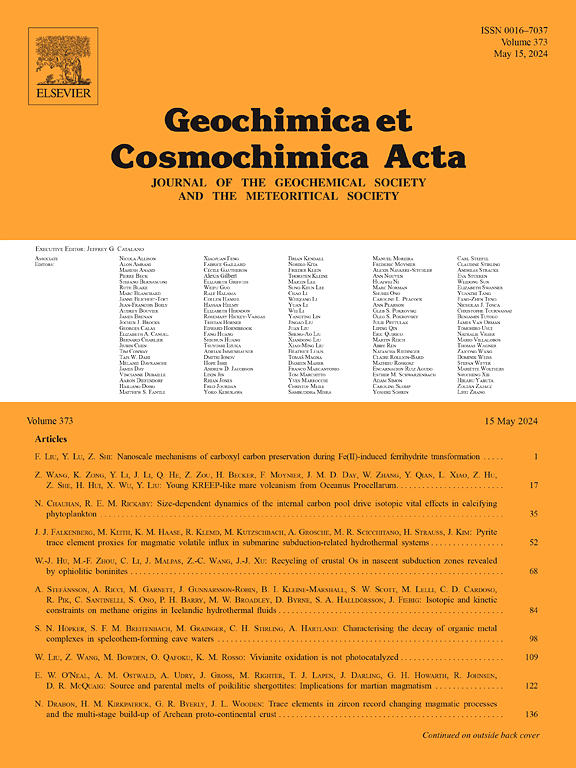Absolute 230Th/U chronologies and Δ47 thermometry paleoclimate reconstruction from soil carbonates in Central Asian loess over the past 1 million years
IF 4.5
1区 地球科学
Q1 GEOCHEMISTRY & GEOPHYSICS
引用次数: 0
Abstract
Pleistocene loess records of the Khovaling Loess Plateau (KLP) in Tajikistan provide rich collections of lithic artifacts demonstrating past human presence in the region. To understand the timing of human activity and environmental conditions prevailing at that time U–Th dating and clumped/stable C/O isotope measurements have been applied to modern and Pleistocene soil carbonates (SCs) collected at several sites on the KLP and surroundings. U–Th ages were corrected by two methods: 1) assuming an initial [230Th/232Th] activity ratio of 0.85 ± 0.25 based on gamma spectrometry of loess/paleosol samples, and 2) the isochron technique using leachates and fully dissolved subsamples. Diagenetic alteration and potential U/Th mobilization and related isotope fractionation due to alpha-recoil was also modelled and found to be minor in the studied soil carbonates. Compared to model ages as references, uncorrected 230Th ages are only acceptable if measured [230Th/232Th] activity ratios of leachates are high (>30), while 230Th ages derived using method 1 are mostly overcorrected. It appears that SCs can be reliably dated by the U-series disequilibrium method in this sedimentary setting, but isochron dating cannot be spared. Application of the isochron method is required to derive 230Thmodel ages, which ensures that the non-zero initial 230Th and possible U–Th gain/loss due to alpha-recoil can be simultaneously corrected and reliable U–Th ages obtained. U–Th ages of Pleistocene SCs clearly demonstrate post-pedogenic ingrowth of multiple, non-contemporaneous populations of SCs within loess/paleosol units, and that SC formation happened in many cases under cold, presumably dry glacial climate conditions. Considering that U–Th ages of SCs provide minimum ages of the sediment in which they form, these ages can be useful in developing loess stratigraphic models and for correlation of paleosols with marine isotope stages. This implies that the age of a given paleosol and any lithic artifacts it may contain, indicating human activity, cannot be younger than the age of SCs formed in that paleosol. This is due to the nature of soil carbonates, which can be the product of both syn- and post-depositional processes.
Clumped isotope thermometry of SCs collected from modern soils at three sites in Tajikistan provide evidence for SCs dominantly recording summer season soil temperatures, while the calculated soil water oxygen isotope signatures reflect annual signals and carbonate precipitation from source waters incorporating rainfall from prior to and during SC formation. In contrast, some Pleistocene SCs record soil temperatures and stable isotope compositions more appropriate to glacial conditions, confirming the findings of U–Th ages, and highlighting the primary role of aridity-driven soil moisture changes in SC precipitation in this setting. Considering the interpretative complexities of SC stable isotope compositions, involving issues such as SC formation depth within a soil/paleosol profile, seasonality of SC growth and violation of the law of superposition, SC stable isotope proxy records of past climates cannot be considered as a set of clearly sequential data through time. This implies that such SC-based stable isotope records must be accompanied by U–Th dating of carbonates to be meaningful.
从中亚黄土的土壤碳酸盐中重建过去 100 万年的 230Th/U 绝对年代学和 Δ47 测温古气候
塔吉克斯坦霍瓦林黄土高原(KLP)的更新世黄土记录提供了丰富的石器文物,显示了该地区过去的人类活动。为了了解人类活动的时间和当时的环境条件,我们对在 KLP 及其周边地区的几个地点采集的现代和更新世土壤碳酸盐(SCs)进行了 U-Th 测定和团块/稳定 C/O 同位素测量。U-Th年龄的校正有两种方法:1)根据黄土/古沉积物样本的伽马能谱测定法,假设初始[230Th/232Th]活度比为0.85±0.25;2)使用浸出液和完全溶解子样的等时线技术。此外,还对所研究的土壤碳酸盐进行了模拟,发现在这些土壤中,α-反弹性引起的成因蚀变和潜在的 U/Th 迁移及相关的同位素分馏现象并不严重。与作为参考的模型年龄相比,未经校正的 230Th 年龄只有在沥滤液的实测[230Th/232Th]活度比很高(30)时才能接受,而采用方法 1 得出的 230Th 年龄大多校正过度。在这种沉积环境中,用铀-序列不平衡法似乎可以可靠地确定 SCs 的年代,但等时测年法却不能幸免。应用等时测年法需要推算出 230Th 模型年龄,以确保非零初始 230Th 和由于α-反 应可能引起的 U-Th 增减能够同时得到校正,并获得可靠的 U-Th 年龄。更新世SC的U-Th年龄清楚地表明,在黄土/古沉积物单元中,多个非同期的SC群体是在成岩后生长的,而且SC的形成在许多情况下是在寒冷、可能是干燥的冰川气候条件下发生的。考虑到 SC 的 U-Th 年龄提供了形成 SC 的沉积物的最小年龄,这些年龄有助于建立黄土地层模型以及古溶胶与海洋同位素阶段的相关性。这意味着特定古沉积及其可能包含的表明人类活动的任何石制品的年龄,都不能小于在该古沉积中形成的沉积物的年龄。这是由土壤碳酸盐的性质决定的,土壤碳酸盐既可能是同沉积过程的产物,也可能是后沉积过程的产物。
本文章由计算机程序翻译,如有差异,请以英文原文为准。
求助全文
约1分钟内获得全文
求助全文
来源期刊

Geochimica et Cosmochimica Acta
地学-地球化学与地球物理
CiteScore
9.60
自引率
14.00%
发文量
437
审稿时长
6 months
期刊介绍:
Geochimica et Cosmochimica Acta publishes research papers in a wide range of subjects in terrestrial geochemistry, meteoritics, and planetary geochemistry. The scope of the journal includes:
1). Physical chemistry of gases, aqueous solutions, glasses, and crystalline solids
2). Igneous and metamorphic petrology
3). Chemical processes in the atmosphere, hydrosphere, biosphere, and lithosphere of the Earth
4). Organic geochemistry
5). Isotope geochemistry
6). Meteoritics and meteorite impacts
7). Lunar science; and
8). Planetary geochemistry.
 求助内容:
求助内容: 应助结果提醒方式:
应助结果提醒方式:


